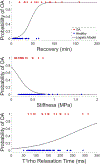Mechanical metrics may show improved ability to predict osteoarthritis compared to T1rho mapping
- PMID: 34627074
- PMCID: PMC8744537
- DOI: 10.1016/j.jbiomech.2021.110771
Mechanical metrics may show improved ability to predict osteoarthritis compared to T1rho mapping
Abstract
Changes in cartilage structure and composition are commonly observed during the progression of osteoarthritis (OA). Importantly, quantitative magnetic resonance imaging (MRI) methods, such as T1rho relaxation imaging, can noninvasively provide in vivo metrics that reflect changes in cartilage composition and therefore have the potential for use in early OA detection. Changes in cartilage mechanical properties are also hallmarks of OA cartilage; thus, measurement of cartilage mechanical properties may also be beneficial for earlier OA detection. However, the relative predictive ability of compositional versus mechanical properties in detecting OA has yet to be determined. Therefore, we developed logistic regression models predicting OA status in an ex vivo environment using several mechanical and compositional metrics to assess which metrics most effectively predict OA status. Specifically, in this study the compositional metric analyzed was the T1rho relaxation time, while the mechanical metrics analyzed were the stiffness and recovery (defined as a measure of how quickly cartilage returns to its original shape after loading) of the cartilage. Cartilage recovery had the best predictive ability of OA status both alone and in a multivariate model including the T1rho relaxation time. These findings highlight the potential of cartilage recovery as a non-invasive marker of in vivo cartilage health and motivate future investigation of this metric clinically.
Keywords: Biomarker; Cartilage mechanical properties; Cartilage recovery; Cartilage stiffness; OA diagnosis; Quantitative MRI.
Copyright © 2021 Elsevier Ltd. All rights reserved.
Figures





References
-
- Armstrong C, Mow V, 1982. Variations in the intrinsic mechanical properties of human articular cartilage with age, degeneration, and water content. J Bone Joint Surg Am 64, 88–94. - PubMed
-
- Ateshian G, Warden W, Kim J, Grelsamer R, Mow V, 1997. Finite deformation biphasic material properties of bovine articular cartilage from confined compression experiments. Journal of Biomechanics 30, 1157–1164. - PubMed
-
- Athanasiou K, Agarwal A, Dzida F, 1994. Comparative study of the intrinsic mechanical properties of the human acetabular and femoral head cartilage. Journal of Orthopaedic Research 12, 340–349. - PubMed
-
- Athanasiou K, Rosenwasser M, Buckwalter J, Malinin T, Mow V, 1991. Interspecies comparisons of in situ intrinsic mechanical properties of distal femoral cartilage. Journal of Orthopaedic Research 9, 330–340. - PubMed
Publication types
MeSH terms
Substances
Grants and funding
LinkOut - more resources
Full Text Sources

